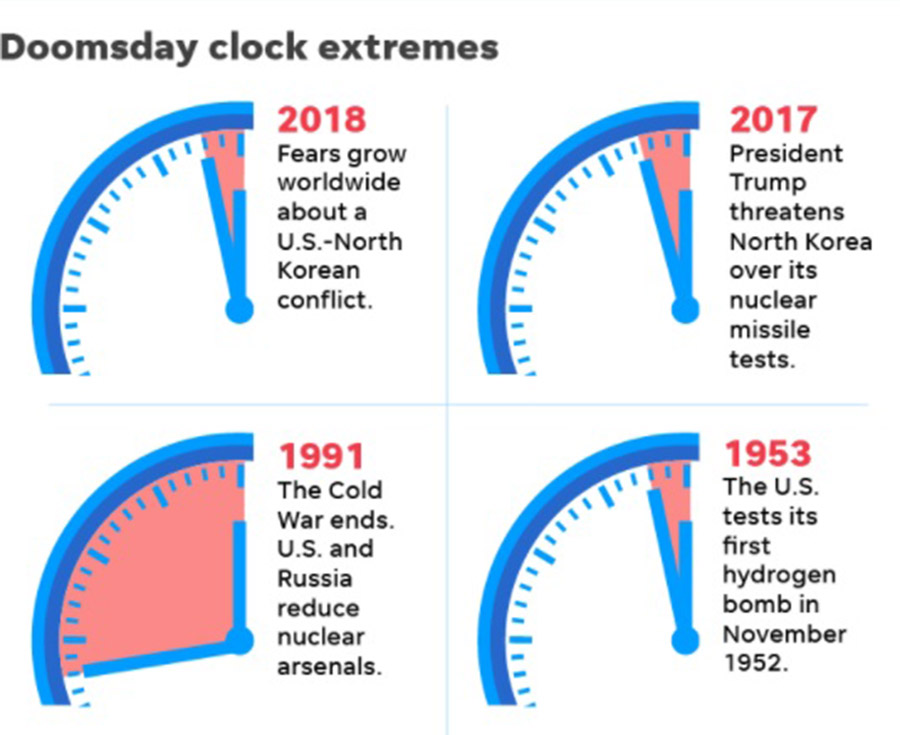

If everything’s a crisis, then nothing’s a crisis. The first known references to the Doomsday Clock didn’t appear in newspapers until 1968, and the Bulletin formally adopted the name in 1972.Ĭritics of the Bulletin and its scary clock have dismissed it as a political stunt, or even counterproductive messaging that is unhelpful to the public and policymakers. For decades it was known simply as the Atomic Clock. and Soviet Union signed the first Strategic Arms Reduction Treaty (START 1) and the Soviet Union dissolved, the clock briefly dipped to 17 minutes before midnight.Ĭatchy as the title is, the clock didn’t get its “doomsday” moniker until relatively recently. No matter: World events have only once raised that happy dilemma. It apparently never occurred to Langsdorf that the editors might someday want to pull that minute hand far below the 45-minute mark. Langsdorf’s design started as an entire clock face, but she soon stripped it down to the last 15 minutes of the hour. Sketching on the back cover of a bound copy of Beethoven’s sonatas, Langsdorf hashed out the concept of a clock with its minute hand sweeping toward midnight-symbolising, as she said, “the urgency and the time of essence.” “Being the so-called artist-in-residence for the scientific community, they asked me to do the first cover for the magazine-to-be,” Langsdorf, who painted under the name “Martyl,” said in an interview before her death in 2013. Martyl Langsdorf, a celebrated landscape artist, was married to physicist Alexander Langsdorf, who worked on the Manhattan Project. Luckily, the Chicago-based scientists in charge didn’t have to look far for a graphic designer. “They wanted people to understand that these weapons could literally end civilisation-and even, perhaps, the human species.” “The editors were afraid that the nuclear weapons they had helped create were not fully understood by either politicians or the public,” says Mecklin. The clock came about simply because the association’s editors-most of whom had been scientists working on the Manhattan nuclear project during World War II-wanted a striking cover for the first issue of the new magazine they were launching. Gabel trace the history of the clock, which they argue is “the most powerful piece of informational design of the 20th century.” In their unnervingly entertaining new book, The Doomsday Clock at 75, Robert K. “But they also realised there would be others.” Powerful wake-up call The early atomic scientists “knew that nuclear weapons were the first human creation that could literally end civilisation,” Mecklin says. In recent years, the committee has even added the rapid spread of disinformation to its growing list of existential threats to humanity. “Climate change, biological threats, artificial intelligence-there are lots of emerging issues that could threaten the planet,” says Mecklin. Now, the Bulletin’s Science and Security Board considers more than just the nuclear threat when deciding where to set the clock’s hands each year. When the clock was first depicted on the June 1947 issue-set at seven minutes to midnight-the editors were concerned solely with the likelihood that atomic bombs would soon rain down on the world’s capitals. That’s a pretty grim way to celebrate your 75th birthday, but as Bulletin editor John Mecklin observes, the ingredients for a possible doomsday scenario are more numerous than ever. The clock is reset every January, and not even at the height of the Cold War, when Americans were digging fallout shelters and kids were being told to “duck and cover” under their school desks in case of atomic attack, were the clock’s hands this far into the final countdown. The iconic clock has been the symbol of the Bulletin of the Atomic Scientistsever since, and as the clock turns 75, the group’s experts say we’re closer than ever to that dreadful wakeup call. In 1947, a group of scientists who had worked on the first nuclear weapons dreamed up the Doomsday Clock as a metaphor warning just how close humanity was to destroying itself.

put it another way: “It's the End of the World as We Know It.” That’s the interval on the symbolic Doomsday Clock between the present moment and “planetary catastrophe.” The alternative rock band R.E.M. Regardless of what your watch tells you, it’s 100 seconds to midnight.


 0 kommentar(er)
0 kommentar(er)
